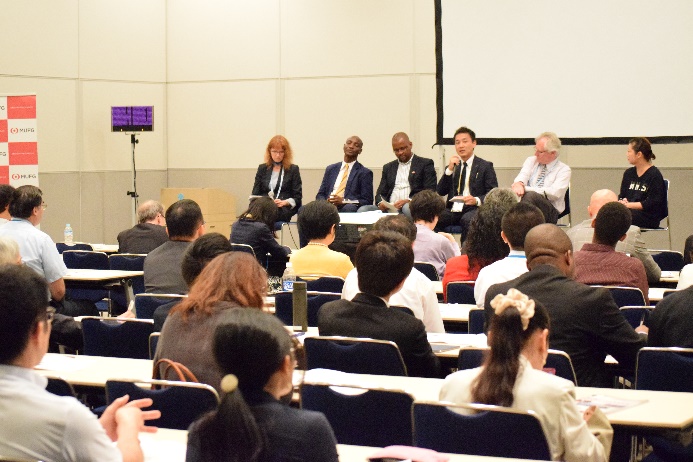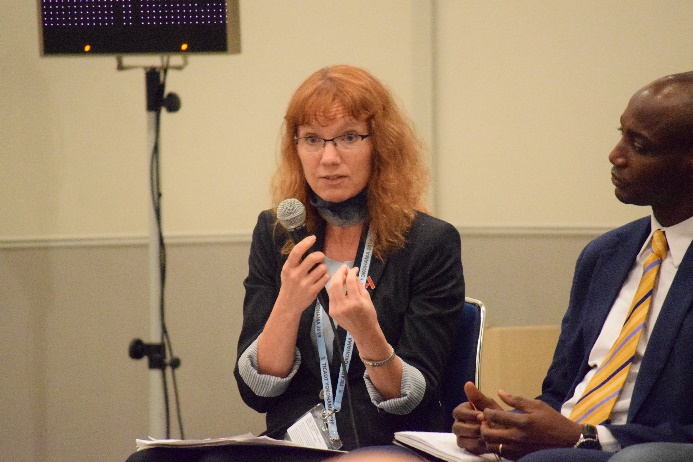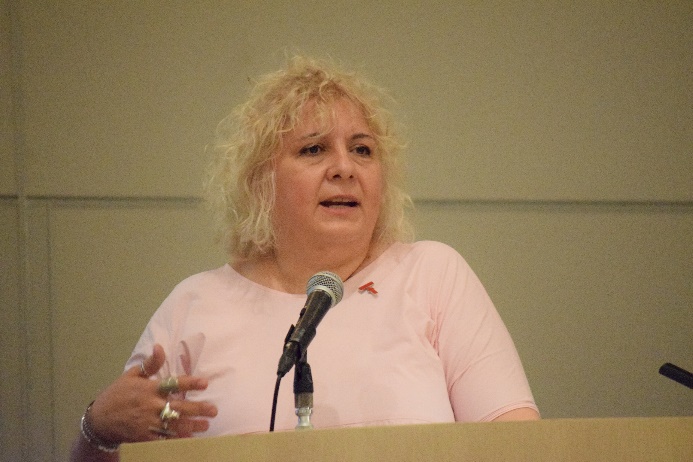Cover photo: George Sabblah, Head, Safety Monitoring Department, Food and Drugs Authority of Ghana speaks during the TICAD7 side event, Digital Health and Data-Driven Innovation in TB Care, held on 28 August 2019 in Yokohama, Japan.
Photos credit: TICAD7
Yokohama – Tuberculosis (TB) remains the biggest killer among infectious diseases in the world, but experts at the Seventh Tokyo International Conference on African Development (TICAD7) last week say breakthroughs in digital health and data-driven innovation could finally provide relief and a much-needed leap forward in treatment for the millions of patients worldwide.
The insights were shared at a TICAD7 side event co-hosted by the Japan Anti-Tuberculosis Association (JATA), Stop TB Partnership, Stop TB Partnership Japan, Results Japan, Mitsubishi UFJ Research and Consulting, International AIDS Vaccine Initiative (IAVI), United Nations Development Programme (UNDP) through the Access and Delivery Partnership (ADP) and Japan International Cooperation Agency (JICA).
The session featured a panel of experts from governments, industry and development partners, and was moderated by Michikazu Koshiba, Head, Center on Global Health Architecture, Mitsubishi UFJ Research and Consulting Co., Ltd. “Digital health and data-driven innovation has great potential for building effective and sustainable health systems, including access and delivery,” and can contribute to achieving universal health coverage, Koshiba said in opening.
Lucica Ditiu, Executive Director, Stop TB Partnership set the stage by offering sobering statistics on the persistence of TB, an ancient disease for which a breakthrough has not been introduced in decades. Without a way to catapult efforts forward such as through digital technologies, the slow decline of TB transmission at less than 2 percent per year will likely continue she said, where a decline of some 5-8 percent or more is needed. “It’s clear we need to do something different,” she said.
The September 2018 UN High-Level Meeting Political Declaration set ambitious targets to treat 40 million people annually by 2022 and called for increased political commitment from countries, as well as at regional and global levels (read this Stop TB Partnership summary of the targets for more info).
TB can be a good example for other diseases of how innovations can be brought into the fight, such as artificial intelligence and digital technology, she said. But tools currently in use and the data collected are “very outdated,” and are not used to the scale necessary, she added. There is progress in tools for rapid diagnosis of TB, testing, shorter treatments, and some promising phase II and III vaccine trials, but “still we are not there,” she said. Only India, with 2 million TB patients, has real-time data.
Dereck Tait, Senior Medical Director, TB Program, IAVI, hailed a promising new vaccine developed by Aeras (now under IAVI) and GlaxoSmithKline as “one of the biggest breakthroughs in over a century” for treating TB. The results of a two-year test conducted in Africa and published last year showed GSK’s M72/AS01E candidate vaccine to have a 54 percent efficacy against TB, according to GSK. Tait said it could take five years or longer to come to market. Importantly, samples taken from study participants can be looked at for correlations to see what those who developed TB had in common, as well as those who did not, Tait said.
George Sabblah, Head, Safety Monitoring Department, Food and Drugs Authority, Ghana, described Ghana’s internationally consistent system of national FDA approval of medicines and technologies for diagnosis and treatment of TB. Products prequalified by the World Health Organization are reviewed within a shorter period, he said.
Ghana’s Food and Drugs Authority has received support from the UNDP through the Access and Delivery Partnership (ADP) for several years in the area of pharmacovigilance to develop technologies for safety monitoring of health technologies including TB products, said Sabblah. Efforts included development of and training in the use of an online reporting system and a mobile app for reporting side effects and therapeutic failures in real time. Digitalization of pharmacovigilance data and the mobile app can be important tools to facilitate access to new treatments for TB, given the need to implement active drug safety monitoring and management for multi-drug resistant TB regimens.
Stephanie Mikulasek, Foreign Service Officer, Deputy Director of the Office of Development Cooperation, United States Agency for International Development (USAID), highlighted USAID’s Global Accelerator to End Tuberculosis, and “new business model [that] will catalyze investments across multiple countries and sectors to end the epidemic while building self-reliance,” according to the programme’s website. The accelerator will focus on locally generated solutions “that tailor TB responses to patients and communities to address the diagnosis, treatment and prevention needs, addressing stigma and discrimination.”
Kagiso Ndlovu, CEO, Ultimate Informatics and lecturer in computer science at the University of Botswana, said Botswana now has a health information department and local systems for data collection, but much is still gathered manually on paper. Innovations are often based on the country’s strong mobile telecommunications network, he said. An example is contact tracing, which allows them to contact patients and collect data.
Masaharu Morita, Global Marketing & New Business Manager, Medical Division, Fujifilm, highlighted a potentially impactful screening technology being developed by Fujifilm in a joint venture with an artificial intelligence company. The product focuses on computer-aided detection that shows outcomes of 90-95 percent accuracy. It is particularly effective in finding a targeted disease such as TB or cancer. The company aims to have the technology ready by year’s end.
The fight against TB stands to benefit greatly from digital and data-driven innovation, which it is hoped will finally give the needed push to overcome this preventable but persistent disease and bring efforts in line with the Sustainable Development Goals’ ambition of ending TB by 2030. Last week's panel highlighted how close these breakthroughs are to fruition and provided incentive for partners to step up efforts to translate innovations to impact.







